Knox Mine Disaster Memorial, Port Griffith
Introduction
Text-to-speech Audio
Images
Workers dumping material into the river in an attempt to combat the water flow. Photo by Stephen N. Lukasik, copyright Lukasik Studio Archives.
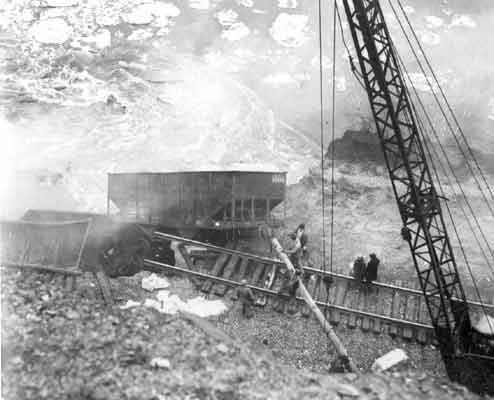
Whirlpool caused by water pouring into the mine shaft. Photo by William R. Lukasik, copyright Lukasik Studio Archives.
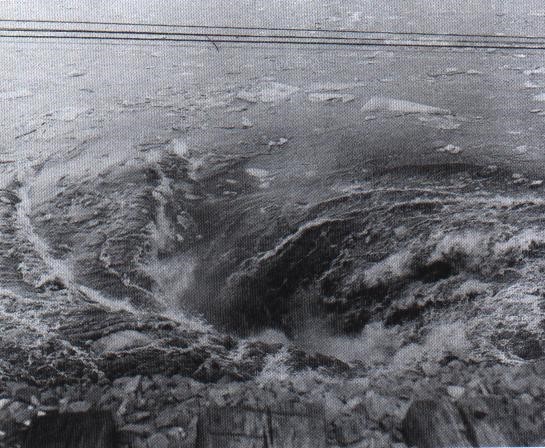
Newspaper regarding the incident and the discovery of the part that mine owners played in causing it.
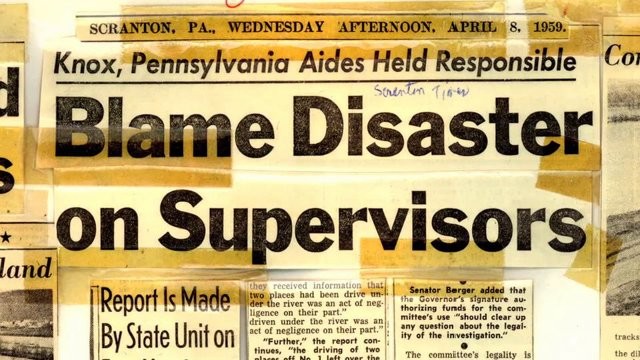
This memorial pays tribute to the victims and the miners who worked to save others. It is located next to St. Joseph's Roman Catholic Church.
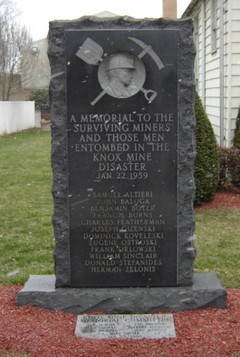
The Knox Mine Disaster: The Final Years of the Northern Anthracite Industry and the Effort to Rebuild a Regional Economy. Click the link to learn more about this book.
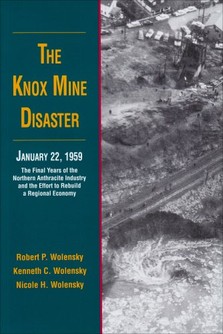
Backstory and Context
Text-to-speech Audio
The Disaster
On January 22nd, 1959, a normal workday quickly became a disaster, and at 11:20 am, two miners in the Pittson shaft heard an audible crack/pop. A full evacuation of the mine was ordered, though the severity of the situation was downplayed by acting superintendent Robert Groves.
The roof of the Pittson vein collapsed, instantly killing three workers and trapping forty-five miners. Trapped by an estimated flow of 2.7 million gallons of water a minute, the miners could only search for a way out while their families and community gathered on the banks.
The trapped miners were separated but eventually formed into two groups. The two groups trekked through tunnels for hours before escaping through the abandoned Eagle air shaft. Twelve miners were never found, their bodies washed away or destroyed by the tremendous water pressure. (Wolensky, 112-130)
Response
Many people gathered at the banks to wait for word on their family members, while at the same time disaster response officials from the company and state worked to respond to the massive amounts of water pouring into the miles of mines in the area.
The intent was, at least in part, to end the flow and save viable veins in the declining but still profitable mines in the valley around the river (Wolensky, 176). The flow was so intense that a massive whirlpool formed in the river, and it wasn’t stopped until 3 days later.
To seal the mine, tons of railroad cars, mine carts, and coal waste were dumped into the opening (Berger, 5). The state of Pennsylvania pumped millions of gallons of water from the mines and passed a 1.5 million dollar bill to the Knox Mine Company, which later declared bankruptcy (Berger, 8).
The Cause
Investigators found that Knox management had ordered miners to dig under the Susquehanna River, in violation of Pennsylvania law and mine safety standards, which recommended at least 35 feet between a river and a mine tunnel.
The tunnel that collapsed in the River Slope mine had less than 6 feet between the shaft and the river (Berger, 8). In investigations after the accident, it was found that mine owners were digging under the river illegally in an attempt to remain profitable and their efforts were enabled by corrupt United Mine Workers Association officials and lax state officials (Dublin, 111).
It was this corruption that led to later criminal trials for several figures involved with the affair, and the corruption, lax safety standards, and higher risk of mining is said to have killed the anthracite coal mining in the region.
Criminal Trial
A subsequent federal and state investigation revealed almost endemic levels of corruption. The parent mine company was found to not only be ignoring violations of safety standards but to be actively encouraging it. Union officials such as UMWA district president August Lippi were also found to be taking bribes in exchange for not objecting to low safety standards.
State officials were shown to be lax in inspection and ignored subsequent operations after the River Slope mine was closed down 9 days before the incident. While ultimately 9 officials were indicted most were overturned on appeal and August Lippi successfully ran for another position within the UMWA (Dublin, 110-113). The criminal trials and the reveal of rampant corruption helped seal the fate of further attempts to operate mines within the region.
Sources
Dublin, Thomas and Walter Licht. The Face of Decline: The Pennsylvania Anthracite Region in the Twentieth Century. Ithica, NY: Cornell University Press, 2005.
Wolensky, Robert C., Kenneth C, Wolensky, and Nicole H. Wolensky. “Voices of the Knox Mine Disaster.” Philadelphia: Pennsylvania Historical & Museum Commission, 1999.
